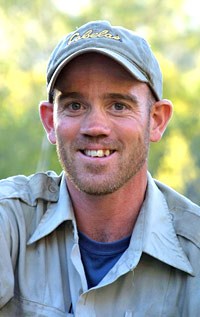
Lori Rome, Seasonal Supervisor - Interpretation In late October 2007, Eric York, wildlife biologist at Grand Canyon, picked up a mortality signal from female mountain lion P13’s radio collar. P13 had been trapped in April 2007 and fitted with a collar equipped with a global positioning system unit and a radio transmitter. Eric inferred from data collected by her collar that she had a litter of kittens early that summer. The mountain lion research program had a busy and successful summer — Eric caught and collared eight lions and documented two litters of kittens, in addition to tracking collared lions and making other field observations. His desire to understand the natural world drove him to find answers, so he performed a necropsy. Did she die of internal bleeding? Had she been attacked by the large male, P4, who frequented her territory? Eric told me that he found teeth marks in the neck, puncture wounds in her abdomen and massive internal bleeding. Her three kittens were now orphaned. 
“They won’t make it,” Eric said when he told me the bad news. “They are only 3 months old, and they still needed their mother for survival.” As sadness came over me, he reminded me that “it is part of the natural process.” The mountain lion research program went from having 10 collared lions to only three. Lions had died, collars had failed, and now the mother and kittens were gone. A dedicated biologist, Eric pushed on. He continued to set new traps and to capture and collar lions. In the last week of October, Eric was scheduled to give a lecture about lions to students at Grand Canyon School. He had packed props, projector and years of wisdom. But he felt ill and was forced to cancel. Although not feeling well, he rose at 4:00 a.m. to check his lion traps. After returning from the field, he went home early, tired with flu like symptoms. A few days later, Eric was found deceased in his home after he failed to come to work. Eric died of pneumonic plague, contracted from his exposure to P13. Though plague is present in the Southwest, human cases are extremely rare. As a wildlife biologist, Eric’s exposure to potential hazards was high, yet he had safely worked with and handled mountain lions, bobcats, coyotes, bighorn sheep, ringtails, squirrels and other wildlife for years. The death of Eric York is a shock and a tragedy. He was admired and respected by everyone, including me. Eric’s death is also a tragedy for mountain lions in the park and for wildlife globally. Eric dedicated his life to researching big cats throughout the United States, and in Pakistan, Chile and Nepal. He worked with the Felidae Conservation Fund and was on their technical advisory board. At only 37 years old, he had so much more to learn and share. His sudden death has halted lion research at the park, for now. 
Eric was amazing. He would rise before dawn to set and then check his lion traps, and briefly stop in the office before returning to the field to check his traps again. Cold or hot, sunny or snowing, Eric was outside with the animals he studied, covering hundreds of miles off trail in the wilds of the park. He found kill sites, followed tracks and monitored activity. Eric learned that lions have large territories here, that Grand Canyon’s lions prey primarily on elk and that people affect lions more than lions affect people. Four lions in a five-year period were killed either in collisions with automobiles on park roadways or by legal hunting outside the park boundary. It was Eric’s plan to educate the public about lion activity in order to decrease human caused lion mortality. It is my hope now to ensure that Eric’s message is communicated. 
Eric was generous with his time and inclusive with his work. He shared his research findings with numerous park staff, from interpretation to law enforcement. He presented trainings and updates about his lion studies, as well as about other wildlife research, including bighorn sheep. With his help, thousands of visitors to Grand Canyon have been able to learn about the majestic mountain lion. As a volunteer on my days off, Eric encouraged me, and sent me out in the field using GPS data from the lions’ collars to locate kill sites and collect data about lion prey. I maintained updates on the lion populations and research at the canyon. Eric allowed me to take an active role in lion research in the canyon, which made me a better park ranger. I will cherish these experiences throughout my life and career, and I am thankful for the two years I spent working with and for this inspirational biologist. 
It is my hope and desire that we can all follow in Eric’s footsteps by making contributions to better our world, by leading life to the fullest and by following our dreams. 
Grand Canyon Mountain Lion Program Archive Mountain Lion Research (2009) Download these articles as they appeared in the Summer 2008 Nature Notes (576kb PDF File) |
Last updated: April 30, 2024
